- Submitted by Dahlia
(Kattu Choru in Banana Leaves, Kerala Pothi Choru, Traditional Grandma Special Lunch Menu)

Jump to recipe ↓
In olden days, lunch was packed by our grandmothers in a unique way. In those days, fancy lunchboxes like today were not common in Indian market. Our grandmothers used to pack lunch in banana leaves for family members going on a long journey or to work. Children who went to school also took this every single day. I remember my dad sharing memories of his childhood days. He and his brother (my chitappa) used to go to a nearby pond to take bath. On the way back, they used to cut a banana leaf from the neighboring banana plantation. They used just some stone lying there to cut the leaf. Isn't it interesting?. Then grandma used to pack their lunch for school.
The speciality of this kattu choru or pothi choru meal was its hygiene and the unique aroma and taste imparted to the meal by the banana leaves. My memories of eating this was when my grandmother used to pack lunch this way during our return train journey from Kanyakumari to Mumbai. The lunch was a simple one with Kerala red chamba rice, aviyal, chammandhi and egg. No gravy is required. Sometimes she would also keep a piece of fish fry or a spoon of some homemade pickle. It was packed in burnt (fire toasted) banana leaves. When the pack was opened after 4-5 hours, it was one comfort meal. I cannot explain in words how it tasted. The flavour and taste of the banana leaves blended with the rice and other items. The whole meal used to be so delicious that I used to end up eating more than I would eat at home. The best part is that we can dispose the leaves and do not have to carry the dirty lunchboxes back home like we do today. Isn't it the most eco-friendly lunch box ever?
Today my grandmother is 88 years old and these have become nostalgic memories. I decided to make my own pothi choru. Pothi Choru, also known as Kattu Choru was the traditional way of packing lunch in banana leaves throughout Kerala. Our native place Kanyakumari was part of Kerala then. Here I am delighted to share our Kanyakumari special Kattu Choru.
Video Instructions for making Pothi Choru
Method of Preparing Pothi Choru
Preparation time: 30 minutes
Cooking Rice: 45 minutes
Serves: 2
Ingredients
- Boiled Kerala Red Rice - 3 cups
- Hardboiled Eggs (or Omelette) - 2
- Coconut Chammandhi - One big ball
- Aviyal - 2 cups
Method
- First cook the rice as Kerala rice takes a little longer to cook. This can be done using the traditional draining method or using pressure cooker.
- In another burner, boil the eggs. Instead of this you can even make egg omelette.
- While this is going on, chop the vegetables to make aviyal. Cook the aviyal in a clay pot to get the traditional taste.
- Finally make the coconut chammandhi.
- If you have fish on hand, you can make fish fry too. I did not have it.
- Once the meal is ready, start packing immediately. The key to getting the best taste is to pack while the rice is still hot.
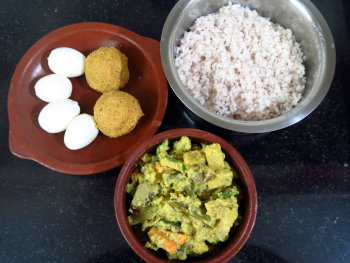
- Wash the banana leaves with water to remove any dirt.
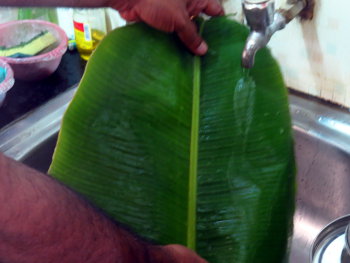
- Toast the banana leaves on open flame till it become soft and slightly burnt. Only then it will fold easily while packing and not tear. It will also disinfect the leaves from microscopic germs.
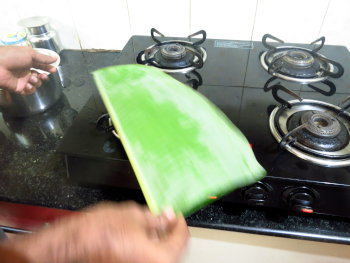
- Spread a newspaper on a flat surface or table. Place the banana leaf on that.
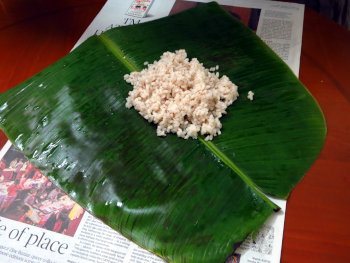
- Put sufficient quantity of rice in the middle. Keep a generous amount of aviyal and chammandhi on top. Next keep the boiled egg. Pickle lovers can add a spoon-full of some pickle too.
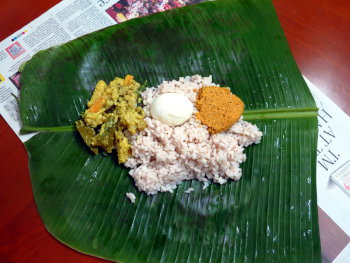
- Fold the leaves to cover all sides as shown below. I have also demonstrated in the video.
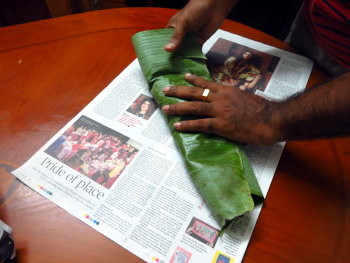
- Once the pack is ready, wrap it in a newspaper. This holds its shape well. To secure it more, you can put a rubberband or tie with a twine. Traditionally, a long banana stem fiber (Vaazhai Naaru) was removed from the banana plant and used for tying. Your lunch parcel is ready.

Serving Pothi Choru
- The lunch parcel needs to rest for atleast couple of hours for the flavours of the rice, banana leaves and the side dishes to blend. Only then you will get the traditional aroma and taste.
More Basic Recipes